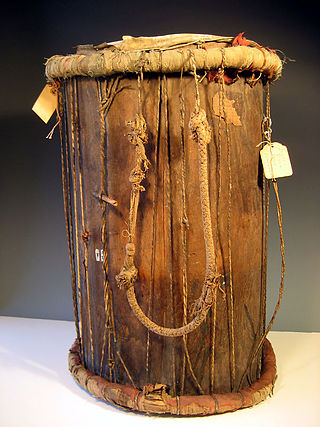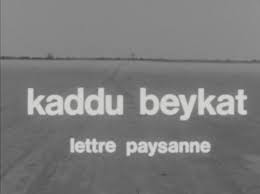
Senegal, officially the Republic of Senegal, is the westernmost country in West Africa, situated on the Atlantic Ocean coastline. It borders Mauritania to the north, Mali to the east, Guinea to the southeast and Guinea-Bissau to the southwest. Senegal nearly surrounds The Gambia, a country occupying a narrow sliver of land along the banks of the Gambia River, which separates Senegal's southern region of Casamance from the rest of the country. It also shares a maritime border with Cape Verde. Senegal's economic and political capital is Dakar.

Senegal's music is best known abroad due to the popularity of mbalax, a development of conservative music from different ethnic groups and sabar drumming popularized internationally by Youssou N'Dour.

Batik is a dyeing technique using wax resist. The term is also used to describe patterned textiles created with that technique. Batik is made by drawing or stamping wax on a cloth to prevent colour absorption during the dyeing process. This creates a patterned negative when the wax is removed from the dyed cloth. Artisans may create intricate coloured patterns with multiple cycles of wax application and dyeing. Patterns and motifs vary widely even within countries. Some pattern hold symbolic significance and are used only in certain occasions, while others were created to satisfy market demand and fashion trends.

The national flag of Senegal is a tricolour consisting of three vertical green, yellow and red bands charged with a five-pointed green star at the centre. Adopted in 1960 to replace the flag of the Mali Federation, it has been the flag of the Republic of Senegal since the country gained independence that year. The present and previous flags were inspired by the French tricolour, which flew over Senegal until 1960.
Mbalax is the urban dance music of Senegal, Mauritania and the Gambia. The musical style is rooted in the indigenous instrumental and vocal styles accompanied by polyrhythmic sabar drumming of the Wolof, a social identity that includes both the original Wolof people of the Greater Senegambia region and the urban panethnic identity that arose during colonialism. A cultural value proved by Wolof is their one's and respect of other cultural and musical practices. Therefore the origins of mbalax include a fusion of Wolof, Soce, and Serer music, rhythms, and instrumentation. The Wolof ability to include the diverse styles from Senegambian groups has allowed the sabar and its modern music formation to thrive. It is not uncommon, for example, for a sabar event to include music of the Serer such as the njuup, which is connected to sacred ndut rite ceremonies. In this way many ethnic groups may participate and the inclusion also increases the accessibilyt and popularity of the genre. In the 1970s, mbalax arose as Senegalese fused indigenous music styles with urban dance music from the African diaspora, the West, and the continent. These foreign sounds included U.S. soul, jazz, and salsa. Afro Cuban musics from the diaspora, Congolese rumba, and rock were also fused with the rhythms of sabar that were now played on the electric bass, guitar and keyboards.

Iba N'Diaye was a Senegalese-born French painter and educator. He trained in Senegal and France during the colonial period, N'Diaye utilized European modernist fine arts training and medium to depict his views of African realities. He returned to Senegal upon its independence, and became the founding head of École Nationale des Beaux Arts in Dakar. Disenchanted with the prevailing artistic and political climate of mid-1960s Dakar, N'Diaye returned to France in 1967 and exhibited around the globe, returning to his birthplace of Saint-Louis, Senegal, to present his work in Senegal again only in 2000. N'Diaye died at his home in Paris in October, 2008 at the age of 80.

The Serer people are a West African ethnoreligious group. They are the third-largest ethnic group in Senegal, making up 15% of the Senegalese population. They also reside in northern Gambia and southern Mauritania.

Senegalese wrestling is a type of folk wrestling traditionally performed by several African tribes, from the Wolofs of West Africa to the Nuer and Dinka of South Sudan. and now a national sport in Senegal and parts of The Gambia, and is part of a larger West African form of traditional wrestling. The Senegalese form traditionally allows blows with the hands (frappe), the only one of the West African traditions to do so. As a larger confederation and championship around Lutte Traditionnelle has developed since the 1990s, Senegalese fighters now practice both forms, called officially Lutte Traditionnelle sans frappe and Lutte Traditionnelle avec frappe for the striking version.

Kaddu Beykat is a 1975 Senegalese film directed by Safi Faye. It was the first feature film made by a Black African woman to be commercially distributed and brought international recognition for its director. Centred on a romance, it chronicles the daily lives of people in a rural Senegalese village.
Kre M’Baye, was a Senegalese portrait artist and art instructor. He was also known as Amadou Kre M’Baye, or Armedy Kre M’Baye.

Moussa Sene Absa, Moussa Sène Absa, or Moussa Sène Absa is a Senegalese film director, editor, producer, screenwriter, painter and songwriter. He was born in 1958 in Tableau Ferraille, a suburb of Dakar, Senegal, to a Serer family.
The Serer religion, or A ƭat Roog, is the original religious beliefs, practices, and teachings of the Serer people living in the Senegambia region in West Africa. The Serer religion believes in a universal supreme deity called Roog. In the Cangin languages, Roog is referred to as Koox, Kopé Tiatie Cac, and Kokh Kox.

Yandé Codou Sène was a Senegalese singer from the Serer ethnic group. She was born in 1932 at Somb in the Sine-Saloum delta and died on July 15, 2010, at Gandiaye in Sénégal. She was the official griot of president Léopold Sédar Senghor. Most of her music is in the Serer language.

Joof or Diouf is a surname that is typically Serer. This surname is also spelt Juuf or Juf.
Tukar a large village in Senegal. Attached to the rural community of Ngayokhem, it is located in the area of the pre-colonial Kingdom of Sine, west of Senegal. The population is overrun by the Serers. As of 2006 to 2007, the population was estimated at 3000. Ndokh, which was a colony of Tukar, is now a separate village.
Louis Diène Faye is a Senegalese anthropologist, author and scholar of Serer religion, history and culture. Himself of Serer heritage, he undertook his secondary schooling at Thiès before proceeding to study religious sciences and audio-visual at the Catholic University of Lyon.
The Njuup tradition is a Serer style of music rooted in the Ndut initiation rite, which is a rite of passage that young Serers must go through once in their lifetime as commanded in the Serer religion.
Religion and beliefs occupy an important place in the daily life of the nation of Senegal. The majority of citizens follow Islam. In 2013, 6% of the population followed indigenous beliefs, while 2% followed Christianity.

The patronym Faye is one of the typical surnames of the Serer people of Senegal, the Gambia and Mauritania. In French-speaking Senegal and Mauritania, and English-speaking Gambia, the surname is spelled Faye.

Toubab Dialo is a village in Senegal, located on the Petite Côte, south of Dakar, between Bargny, Senegal and Popenguine. It is part of the rural community of Yenne, the department of Rufisque and the region of Dakar.












